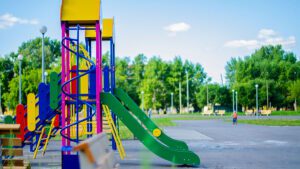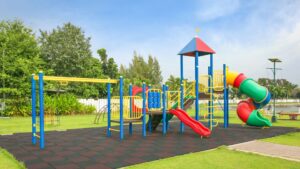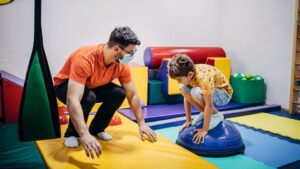يمكن أن يكون افتتاح حديقة ترامبولين خطوة تجارية مثيرة - وقد تكون مربحة -. ولكنها أيضاً تتطلب رأس مال كبير. إذا كنت جاداً بشأن افتتاح منتزه، فأنت بحاجة إلى ميزانية واضحة تغطي الإعدادات الأولية والسلامة والامتثال والعمليات الجارية وتغطية تكاليف ما هو غير متوقع.
ملخص سريع (إذا كنت في عجلة من أمرك)
- نطاق بدء التشغيل النموذجي (المعدات + التجهيزات): $233,000–$467,000 (تقدير الحديقة المتوسطة)
- التأمين (سنوي): $5,800–$11,700 (تقديري)
- دوافع التكلفة الرئيسية: المبنى (الشراء مقابل الإيجار)، واختيار المعدات، وتجديدات الموقع، والتوظيف، والتسويق، وأنظمة السلامة، والصيانة.
- نصيحة: خطّط للمراحل - افتتِح بمناطق الجذب الأساسية، ثم أضف الميزات بمجرد استقرار التدفق النقدي.

1. شرح التكاليف الأولية الرئيسية
1.1 البناء: الشراء أم الإيجار أم البناء الجديد؟
- الشراء يوفر استقراراً طويل الأجل ولكنه يتطلب نفقات مقدمة أكبر وربما تجديدات كبيرة. توقع احتياجات رأسمالية أعلى ولكن مع تحكم أكبر.
- الاستئجار يقلل من رأس المال الأولي ويتيح لك الافتتاح بشكل أسرع، ولكن شروط الإيجار يمكن أن تحد من القدرة على إجراء تعديلات هيكلية (ويمكن أن يرتفع الإيجار).
- الإنشاءات الجديدة مثالي للتخطيط المخصص ولكنه يستغرق وقتاً أطول (غالباً ما يستغرق عاماً أو أكثر) ويكلف أكثر.
يشكل اختيارك العديد من التكاليف النهائية: التدفئة والتهوية وتكييف الهواء، ومتطلبات ارتفاع السقف، والدعامات الهيكلية لأماكن الجذب الطويلة، ومواقف السيارات.
1.2 المعدات وعوامل الجذب (البنود الكبيرة)
حدائق الترامبولين الحديثة هي مراكز متعددة الأنشطة. تشمل عوامل الجذب النموذجية ما يلي:
- قفزات الترامبولين المفتوحة
- ممرات البهلوان
- حفر الرغوة والوسائد الهوائية
- ملاعب دودج بول
- كرة السلة الترامبولين/كرة السلة الترامبولين
- دورات الحواجز بأسلوب النينجا
- الميزات التفاعلية وميزات الواقع المعزز
متوسط ميزانية المعدات لمتنزه متوسط الحجم قُدرت قيمته ب $200k-$400k. يعتمد هذا النطاق على عدد وتنوع عوامل الجذب، والتخصيص، والمعدات الجديدة مقابل المستعملة.
1.3 التخطيط والسلامة والأعمال الإنشائية
لا تبخل على نفسك:
- الأرضيات وحشوة الصدمات
- مخارج الحريق، ومرشات الحريق، وكاشفات الدخان
- دعامات ومثبتات هيكلية متينة
- الإضاءة والصوت والتهوية
- تسهيلات الوصول إلى ADA ودورات المياه
تختلف تكاليف البناء هذه اختلافاً كبيراً حسب حالة المبنى الذي اخترته ولكن غالباً ما تنافس تكاليف المعدات في العقارات القديمة.

2. تكاليف التشغيل التي يجب أن تخصص لها ميزانية
2-1 الموظفون
تتطلب حديقة الترامبولين عدداً كبيراً من الموظفين. تشمل الأدوار ما يلي:
- مكتب الاستقبال/الاستقبال
- مشرفو/مشرفو الترامبولين (موظفو السلامة)
- موظفو المأكولات والمشروبات (إن أمكن)
- منسقو الفعاليات (الحفلات وحجوزات الشركات)
- عمال النظافة وفنيو الصيانة
- المدير ومساعدو المديرين
قاعدة عامة: وجود مشرف واحد مدرب على الأقل لكل 30 لاعبًا تقريبًا. إذا كانت حديقتك تعمل لساعات طويلة (أكثر من 70 ساعة/الأسبوع)، فتوقع أن يكون لديك فريقان كاملان.
2.2 الصيانة وقطع الغيار
تحتاج المعدات إلى عناية مستمرة: استبدال الحشو والنوابض والحصائر والأجهزة. تقلل الصيانة الوقائية من وقت التعطل ولكنها تكلف أموالاً. خطط لميزانية صيانة سنوية وتتبع دورات الاستبدال للعناصر عالية التآكل.
2.3 التسويق واكتساب العملاء
تخصيص ميزانية تسويقية مجدية لـ
- الإعلانات الرقمية المحلية (جوجل/فيسبوك/إنستجرام)
- الفعاليات والشراكات المدرسية
- العلاقات العامة والتواصل المجتمعي
- العروض الترويجية الموسمية
من الضروري وجود خطة تسويقية قوية في المرحلة الافتتاحية لتسريع عملية التسويق الشفهي وتوليد حجوزات مبكرة للحفلات والمجموعات.
2.4 التأمين وإدارة المخاطر
التأمين غير قابل للتفاوض. التقدير الأصلي لـ $5,000-$10,000 سنوياً. يغطي هذا التأمين مخاطر المباني/الممتلكات وتأمين المسؤولية. تعتمد الأقساط الفعلية على الموقع وسجل المطالبات وتدابير السلامة وحدود التغطية.
استثمر في تدريب الموظفين وأنظمة السلامة الموثقة - تكافئ شركات التأمين المشغلين ذوي المخاطر المنخفضة بأسعار أفضل.

3. استراتيجيات التمويل
3.1 طرق التمويل المشتركة
- القروض المصرفية / الإقراض التجاري: الخيار التقليدي؛ قارن بين أسعار الفائدة وشروط السداد.
- مستثمرو الأسهم: يمكن للمستثمر ضخ رأس المال مقابل الملكية، ولكن توقع تغييرات في الحوكمة وتوقعات التخارج.
- المنح: نادرة بالنسبة للترفيه، ولكن قد تنطبق بعض منح التنمية الاقتصادية المحلية أو صناديق الأعمال الصغيرة.
- تمويل البائعين/التأجير المنتهي بالتمليك: في بعض الأحيان تقدم الشركات المصنعة للمعدات خيارات تمويل.
3.2 نصائح الميزانية
- الطرح على مراحل: افتح مع عناصر الجذب الأساسية وأضف ميزات متخصصة لاحقاً.
- توقعات الإيرادات المتحفظة: لا تبالغ في تقدير الحضور - قم ببناء خطتك النقدية على أرقام واقعية.
- الصندوق الاحتياطي: الاحتفاظ بمخصص طوارئ (10-201 تيرابايت 3 تيرابايت من النفقات الرأسمالية الأولية) لتجاوز التكاليف غير المتوقعة.

4. اعتبارات التصميم وتجربة الضيف
4.1 التدفق والرؤية
تصميم خطوط رؤية واضحة حتى يتمكن المشرفون وأولياء الأمور من مراقبة النشاط بسهولة. افصل المناطق عالية الطاقة (كرة المراوغة ودورات النينجا) عن مناطق الأطفال الصغار والعائلية.
4.2 أماكن الحفلات والمناسبات
تُعد حفلات أعياد الميلاد والفعاليات الجماعية محركاً للإيرادات - صمم غرفاً مخصصة للحفلات لتحقيق الكفاءة في إقامة الحفلات وعمليات البيع.
4.3 المأكولات والمشروبات
أضف مقهى بسيط أو مطعم للوجبات الخفيفة للحصول على إيرادات وقت الإقامة. فكر في التأجير لشريك إذا لم تكن خدمة الطعام من اختصاصك الأساسي.
4.4 إمكانية الوصول والشمولية
ضمان الامتثال لمعايير ADA ومراعاة الجلسات الملائمة للحواس للزوار ذوي التنوع العصبي.

5. السلامة والامتثال: أمور غير قابلة للتفاوض
- الامتثال لقوانين البناء المحلية وأي معايير سلامة صناعية.
- تنفيذ قواعد السلامة المكتوبة واللافتات والإحاطات التوجيهية بقيادة الموظفين.
- احتفظ بقوائم المراجعة اليومية وسجلات الصيانة.
- توفير مجموعات إسعافات أولية وأجهزة مزيل الرجفان القلبي الرئوي وموظفين مدربين في الموقع.
تقلل أنظمة السلامة القوية من المسؤولية وتزيد من ثقة العملاء - وكلاهما أمران أساسيان للنجاح على المدى الطويل.

6. تدفقات الإيرادات وعوامل الربح
- رسوم الدخول العام ورسوم القفز بالساعة
- حفلات أعياد الميلاد والحجوزات الجماعية
- العضويات والبطاقات الموسمية
- البضائع والامتيازات
- فعاليات الشركات وباقات بناء الفريق
- فعاليات خاصة بعد ساعات العمل (دروس اللياقة البدنية، ودوريات الترامبولين)
زيادة الإنفاق لكل زائر إلى أقصى حد من خلال الإضافات (الجوارب والخزائن وباقات الصور).

7. المشورة العملية من المشغلين
- إجراء دراسة متعمقة للسوق:: التركيبة السكانية والمنافسة والتقويمات المدرسية وحساسية الأسعار المحلية.
- اختر الموقع بحكمة:: إمكانية الوصول ومواقف السيارات مهمة بقدر أهمية الإيجار.
- إعطاء الأولوية للسلامة:: يمكن لحادث سلامة واحد أن يضر بالسمعة.
- التوظيف والتدريب الجيد:: يحافظ الموظفون المتميزون على سلامة النزلاء وعودتهم
- ابدأ من المرونة والتوسع:: تحقق من صحة مفهومك، ثم قم بتوسيع نطاقه.
يمكن لمنتزه الترامبولين أن يكون مركزاً مجتمعياً مبهجاً ومشروعاً مربحاً - ولكن فقط بالتخطيط الشامل. خطط بشكل واقعي لرأس المال الأولي (توقع ≈ $233k-$467k بالنسبة للمنشأة المتوسطة)، ضع في اعتبارك التأمين السنوي (≈ $5.8k-$11.7k)، وإعطاء الأولوية للسلامة والتسويق منذ اليوم الأول. من خلال التمويل الذكي، والطرح التدريجي، والعمليات القوية، يمكنك بناء منطقة جذب مستدامة وممتعة تحافظ على عودة العملاء.




